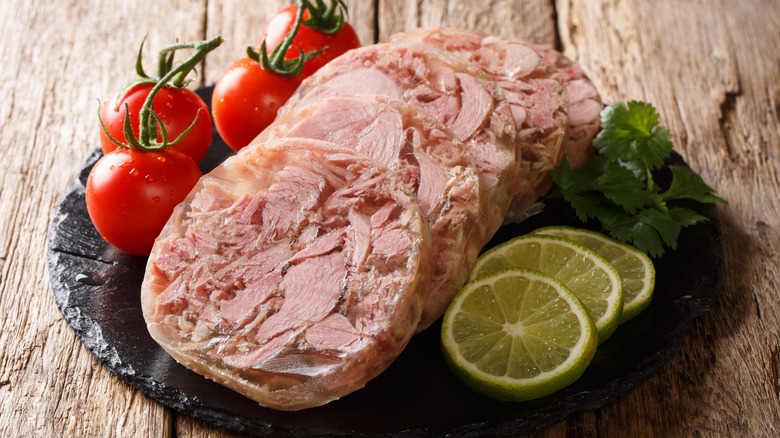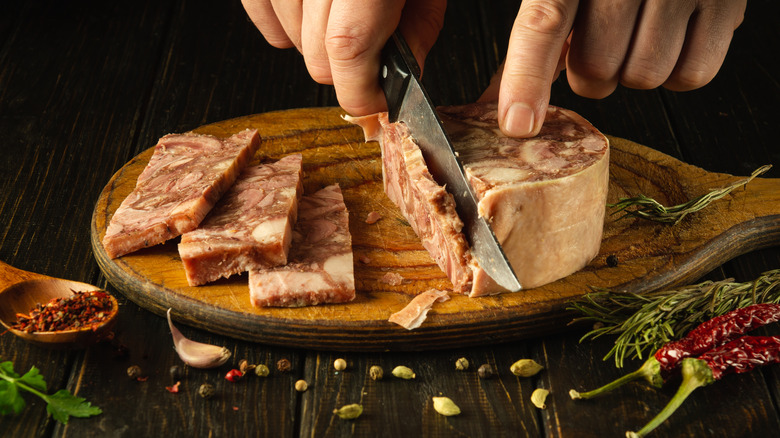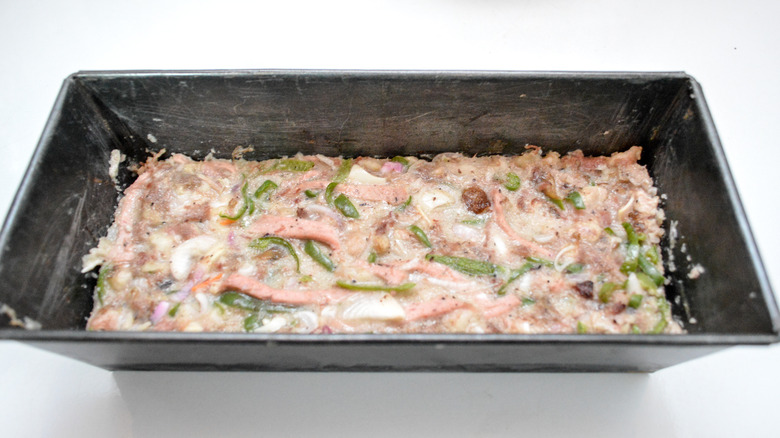How Head Cheese Got Its Unsettling Name
There are spreadable meats, like pâté and terrines, that are considered downright chic. So much so that their appearance on a charcuterie spread or picnic basket tells you the host pulled out all the stops to make the nosh special. Head cheese typically doesn't make that cut. Despite the fact that it is essentially made with the same things that pâté or terrines are made of, its unappetizing-sounding name keeps many people away. Head cheese is a perfect example of nose-to-tail eating, which more and more people are embracing as a sustainable and delicious way to eat. Yet, poor head cheese hasn't been given its due.
The dish is made primarily from the meat bits that come off of a hog's head when it is boiled, thus the "head" title. As far as the "cheese," goes, some believe it refers to the fact that the meat mixture was poured into cheese molds to cool and form. Others assume it is based on the texture of head cheese, which some describe as being similar. In point of fact, head cheese is a type of aspic, or savory, jellied product typically made with meat, and has nothing whatsoever to do with cheese. Some aspics, however, like this preserved lemon and olive one, have nothing whatsoever to do with meat.
Nothing cheesy about it
Head cheese has been around since the Middle Ages, where it was popular amongst the peasant populations in Europe. They would take the less readily consumable bits of an animal and make use of them. In the case of head cheese, they would boil a whole hog's head. During the cooking process, all traces of meat plus the collagen from the connective tissue would be released into the water. The liquid and meat were then poured into molds and cooled; what resulted was a solid, edible loaf of meat bits, not unlike a perfect meatloaf, except it was cold and lacked the ketchup on top. After unmolding, the loaf could be sliced and consumed.
Head cheese hasn't changed much since its inception, except today, other parts of the hog might be incorporated into the mix, like the heart and feet. As it's similar to pâté and terrine, ultra savory head cheese is popularly eaten on crackers or bread and accompanied by tart or sour condiments, such as mustards and pickled vegetables. It isn't the prettiest dish in the world to behold, but truthfully, neither is terrine nor pâté, however, some might be caught off guard by the jellied element of head cheese. Flavor-wise, however, the latter will usually have larger chunks of meat, whereas the former two are often silky-smooth.
Put your own spin on head cheese
In his 1732 cookbook, "The Compleat City and Country Cook," Charles Carter wrote a recipe for head cheese that required only two ingredients: a hog's head and salt. But you can do a lot better than that. Homemade head cheese can be flavored with fresh herbs and spices, and you could even add things like chopped vegetables, dried fruit, and hard boiled eggs to the unchilled mold to give the dish more flavor and color. To flavor the boiling water itself which will, in turn, flavor the dish, consider adding aromatics like onions, celery, carrots, leeks, peppercorns, and a bouquet garni. Adding a touch of vinegar will add sharpness to the otherwise super-savory head cheese.
Making your own head cheese will definitely take some time, as the process of fully breaking down a hog's head in boiling water takes several hours. You'll then need to allow time to separate the meat bits from the bones and excess fat. Once the liquid and meat is poured in a mold, it will need to chill overnight as well. But, the process will be well worth it for any meat lover or anyone who appreciates giving new life to an otherwise underappreciated treat.


